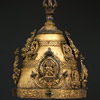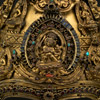Crowns of the Vajra Masters: Ritual Art of Nepal
Vajracarya Priest's Crown
Nepal, Early Malla period, 13th–early 14th century
Gilt-copper alloy inlaid with semiprecious stones, lapis lazuli, and turquoise
H. 12 in. (30.5 cm); W. 9 in. (22.9 cm); D. 8 1/4 in. (21 cm)
Gift of Barbara and David Kipper, 2016
The Metropolitan Museum of Art, 2016.408
The conical crown is unique to Newar Buddhism and represents older, now-lost Indian Buddhist practices. This example is exceptional for its complexity: It is dominated by a series of diadem plaques depicting various emanations of the wisdom bodhisattva Manjushri, who is both benign and wrathful, and eight smaller plaques of gift-granting goddesses. A five-pronged thunderbolt (vajra) scepter surmounts the crown. This unique iconography indicates that the crown was designed for enacting rites dedicated to invoking Manjushri.
Exhibition History
New York. The Metropolitan Museum of Art. "The Arts of Nepal and Tibet: Recent Gifts," January 16, 2016-January 15, 2017.
New York. The Metropolitan Museum of Art. "Crowns of the Vajra Masters: Ritual Art of Nepal," December 16, 2017-December 16, 2018.


